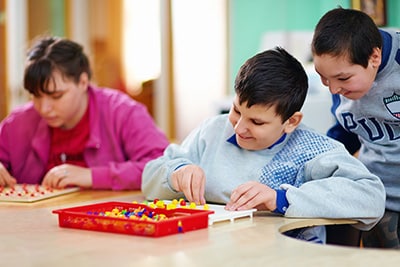
“My mama always said, ‘Life was like a box of chocolates. You never know what you’re gonna get.’”
Sounds familiar? Yes, that’s the famous line from the award-winning movie, “Forrest Gump.” Is it 23 years ago already when it hit the theaters? Along with remarkable quotes we can still remember to today was Tom Hanks convincing portrayal of the main character. However, the film itself gained divided critics – many critics either love or totally hated the movie. But let’s save criticizing the movie some other time. For now, let’s discuss what makes the “Forrest Gump” interesting!
“Stupid is as stupid does.” That was his famous answer when somebody asked him, “Are you stupid?”
Forrest is slow-witted and has an IQ of 75. Although Forrest is just a fictional character, in today’s real world he is considered suffering from intellectual disability. Children with intellectual disabilities may qualify for special education services under the Individuals with Disabilities Education Act, or IDEA. Students who are eligible for IDEA receive an Individualized Education Plan, or IEP, in which a specialized education plan is made for the child based on her educational needs.
Intellectual disability, formerly labeled “mental retardation,” is defined by the Individuals with Disabilities Education Act (IDEA) as “significantly subaverage general intellectual functioning, existing concurrently [at the same time] with deficits in adaptive behavior and manifested during the developmental period, that adversely affects a child’s educational performance.” There are two key components within this definition: a student’s IQ and his or her capability to function independently, usually referred to as adaptive behavior.
An intellectual disability is not a disease. You can’t catch an intellectual disability from anyone. It’s also not a type of mental illness, like depression. There is no cure for intellectual disabilities. However, most children with an intellectual disability can learn to do many things. It just takes them more time and effort than other children.
Intellectual disability is one of the most common developmental disability, more than 425,000 children (ages 3-21) have some level of intellectual disability and receive special education services in public school under this category in IDEA. In fact, 7% of the children who need special education have some form of intellectual disability.
Signs of Intellectual Disability
- sit up, crawl, or walk later than other children;
- learn to talk later, or have trouble speaking,
- find it hard to remember things,
- not understand how to pay for things,
- have trouble understanding social rules,
- have trouble seeing the consequences of their actions,
- have trouble solving problems, and/or
- have trouble thinking logically.
“Mama always had a way of explaining things so I could understand them.”- Forrest
Although Forrest received little to no support at all, and his resources were insufficient, he was blessed with a wise, sassy and loving mom. I remember a scene in which no school would like to accept him. But her mom was so determined to get him in in a regular school. So she moved mountains. Hmm… I guess we don’t want to talk about it here again. Anyway, that’s no longer the case of today’s education.
Educational Considerations
A child with an intellectual disability can do well in school but is likely to need the individualized help that’s available as special education and related services. The level of help and support that’s needed will depend upon the degree of intellectual disability involved.
General education. It’s important that students with intellectual disabilities be involved in, and make progress in, the general education curriculum. That’s the same curriculum that’s learned by those without disabilities. Be aware that IDEA does not permit a student to be removed from education in age-appropriate general education classrooms solely because he or she needs modifications to be made in the general education curriculum.
Supplementary aids and services. Given that intellectual disabilities affect learning, it’s often crucial to provide support to students with ID in the classroom. This includes making accommodations appropriate to the needs of the student. It also includes providing what IDEA calls “supplementary aids and services.” Supplementary aids and services are supports that may include instruction, personnel, equipment, or other accommodations that enable children with disabilities to be educated with nondisabled children to the maximum extent appropriate.
Thus, for families and teachers alike, it’s important to know what changes and accommodations are helpful to students with intellectual disabilities. These need to be discussed by the IEP team and included in the IEP, if appropriate.
Adaptive skills. Many children with intellectual disabilities need help with adaptive skills, which are skills needed to live, work, and play in the community. Teachers and parents can help a child work on these skills at both school and home. Some of these skills include:
- communicating with others;
- taking care of personal needs (dressing, bathing, going to the bathroom);
- health and safety;
- home living (helping to set the table, cleaning the house, or cooking dinner);
- social skills (manners, knowing the rules of conversation, getting along in a group, playing a game);
- reading, writing, and basic math; and
- as they get older, skills that will help them in the workplace.
Transition planning. It’s extremely important for families and schools to begin planning early for the student’s transition into the world of adulthood. Because intellectual disability affects how quickly and how well an individual learns new information and skills, the sooner transition planning begins, the more can be accomplished before the student leaves secondary school.
IDEA requires that, at the latest, transition planning for students with disabilities must begin no later than the first IEP to be in effect when they turn 16. The IEP teams of many students with intellectual disabilities feel that it’s important for these students to begin earlier than that. And they do.
(An excerpt from parentcenterhub.org: Intellectual Disabilities)
See Epic Special Education Staffing Special Education Teacher Jobs
Modification for Students with Intellectual Disabilities
Children with intellectual disabilities need some additional support and modifications in their environment, as well as in the type of activities they do. Here are a few modifications for students with an intellectual disability that will help them to learn better.
- Quiet Work Space
Using this space only for studying also will help the child get into a routine of studying and also understand that when he is sitting there, he is supposed to concentrate on the activity or task, and not play.
- Functional Activities
Teach practical things that will be useful, such as how to boil an egg or how to find their way to their friend’s house.
- Repetition of Concepts Over the Day
Children with intellectual disabilities need to learn a concept in different ways and have the opportunity to practice it many times in order to learn and remember it.
- Teacher-Student Ratio
These children require additional support and guidance as they work on their activities. Ideally, there should be at least 1 teacher for every 3 children with intellectual disabilities.
- Hands-on Learning
Using all the senses to learn also helps them learn and retain information better.
- Safety Measures
Sharp scissors, knives, etc. must be kept out of reach. Harmful liquids like cleaning liquids must also be kept away. Medicines must be kept out of reach. In addition to this, make sure that none of the children can lock themselves up in any room. Small beads or other toy parts that the children could put in their mouth must be kept away if a child has a tendency to do that. If the child has seizures, you may need to look at padding the corners of furniture to avoid injury.
- Schedule
The schedule must have short activity times and must alternate between physical and sitting down activities. The schedule must also try and incorporate some aspects of self-care so that children start becoming more independent in putting on or taking off shoes, going to the toilet, or feeding themselves.
(Access full article here: Special Ed: Modification for Students with Intellectual Disabilities by brighthubeducation.org)
Teaching Practical Tips for Special Education Teachers
- Recognize that you can make an enormous difference in this student’s life!
Learn more about intellectual disabilities in general and your student in particular.
- Be an active participant in the student’s IEP team.
The IEP is developed by the student’s parents and school personnel—and, often, the student, too. As this student’s teacher, you have a great deal to contribute to what’s included in the IEP, including supports for you as the teacher.
- Provide accommodations and supports that help students with intellectual disabilities.
Accommodations are often made in five main areas:
- scheduling (e.g., giving the student extra time to complete an assignment or test)
- setting (e.g., having the student work in a small group or with a partner)
- materials (e.g., providing the student with teacher notes or taped lectures)
- instruction (e.g., breaking a lesson up into smaller parts, having the student work with a tutor)
- student response (e.g., allowing the student to respond orally or on a computer)
- Be as concrete as possible.
An effective teaching method is to demonstrate what you mean in addition to giving verbal directions. With new information shared verbally, also show a picture. And rather than just showing a picture, provide the student with hands-on materials and experiences and the opportunity to try things out.
- Go step by step.
Break longer, new tasks into small steps. Demonstrate the steps. Have the student do the steps, one at a time. Provide assistance, as necessary. Give the student multiple opportunities to practice each individual step by itself and all the steps together.
- Give immediate feedback.
Immediately providing feedback helps the students make a connection between their answers, behaviors, or questions and the information you’re presenting as the teacher.
- Help the student learn life skills.
Schools play an important part in helping students with ID learn these life skills, which include health and safety, personal hygiene, manners, getting along with others, basic math and reading, money management, and skills for the workplace.
- Address the social aspects of the school.
Students with intellectual disabilities often have trouble with social skills, which can make it difficult for them to interact appropriately with their peers and become involved in the social activities going on at school. They are also often a target for bullying, which simply cannot be allowed. Teachers can play a positive role in supporting the inclusion of students with intellectual disabilities in classrooms and throughout the school.
- Communicate with your student’s parents.
Regularly exchange information with parents and work with them (and other members of the IEP team) to create and implement an IEP tailored to meet the student’s needs.
(Source: Intellectual Disabilities in Your Classroom: 9 Tips for Teachers)
5 Tips for Success
- Teach Baby Steps
This term is intended to encourage teachers to break down their lessons into simple, easier-to-manage steps. This will keep frustration levels down and enable learning to take place. Wait until the student masters the baby step before moving onto the next one.
- Concrete Learning Experiences
Introduce new ideas in a physical, hands-on approach. Use manipulatives when teaching math. Take field trips to the grocery store or post office to give students a meaningful experience. When students are able to make real connections to the world around them, or physically explore a concept, the knowledge will stick with them.
- Immediate and Positive Feedback
Positive feedback will encourage the student to keep on trying. If a student masters a concept or meets a goal it is important to reward or applaud the student immediately.
- Sing a Song
Music is a wonderful motivator among all children and particularly ones with intellectual disabilities. Making a simple, catchy song to go along with a concept is a fun way to engage the student and help them remember information.
- Patience
Students with certain disabilities can be unpredictable in what they can learn and what might set off a certain behavior. What might appear to be a temper tantrum is often the student’s way of telling you, “This is too hard. I am frustrated,” or “I am tired. I need a break.” Take the time to learn the individual child’s needs and who they are. If you are feeling overwhelmed and cannot relate to the student it is OK to stop the lesson and resume when both student and teacher can handle the lesson pace. It may take a while for students to make some progress, but if you are patient it will be priceless when they do.
(Source: Five Tips for Teaching Students with Intellectual Disability by brighthubeducation.org)
Other Helpful Links for Teaching Students with Intellectual Disabilities
- Intellectual Disabilities by LumenLearning.com
- Effective Teaching Methods for People with Intellectual Disabilities by gulfbend.org
- Intellectual Disability Strategies by do2learn.com
- Intellectual Disabilities by specialeducationguide.com
GUIDE FOR PARENTS OF CHILDREN WITH INTELLECTUAL DISABILITIES
Help for Babies and Toddlers
When a baby is born with an intellectual disability, his or her parents should know that there’s a lot of help available—and immediately. Shortly after the diagnosis of ID is confirmed, parents will want to get in touch with the early intervention system in their community. We’ll tell you how in a moment.
Early intervention is a system of services designed to help infants and toddlers with disabilities (until their 3rd birthday) and their families. It’s mandated by IDEA. Staff work with the child’s family to develop what is known as an Individualized Family Services Plan, or IFSP. The IFSP will describe the child’s unique needs as well as the services he or she will receive to address those needs. The IFSP will also emphasize the unique needs of the family, so that parents and other family members will know how to help their young child with intellectual disability. Early intervention services may be provided on a sliding-fee basis, meaning that the costs to the family will depend upon their income.
To access early intervention services in your area, ask your child’s pediatrician for a referral or call the local hospital’s maternity ward and ask for contact information for your local services program.
Help for School-Aged Children
School staff will work with the child’s parents to develop an Individualized Education Program or IEP. The IEP is similar to an IFSP. It describes the child’s unique needs and the services that have been designed to meet those needs. Special education and related services are provided at no cost to parents.
To access special education services for a school-aged child in your area, get in touch with your local public school system. Calling the elementary school in your neighborhood is an excellent place to start.
Tips for Parents
- Learn about intellectual disability.
- Be patient, be hopeful.
- Encourage independence in your child.
- Give your child chores.
- Give your child frequent feedback.
- Find out what skills your child is learning at school.
- Find opportunities in your community for social activities.
- Talk to other parents whose children have an intellectual disability.
- Meet with the school and develop an IEP to address your child’s needs.
- Take pleasure in your beautiful one.
(Read the entire article here: Intellectual Disability by parentcenterhub.org)
We are not affiliated with all the organization and educators mentioned in this article. We just couldn’t help but share their wonderful inputs and goals in making lives of students with intellectual disability a little better. Because people, especially intellectual disabled children need to meet a person who will touch their lives in every way or the other to be the best that they can be. Just like Jenny, Lt. Dan, and Mrs. Gump in Forrest’s life.
“I don’t know if we each have a destiny, or if we’re all just floatin’ around accidental-like on a breeze. But I, I think maybe it’s both.” – Forrest Gump




